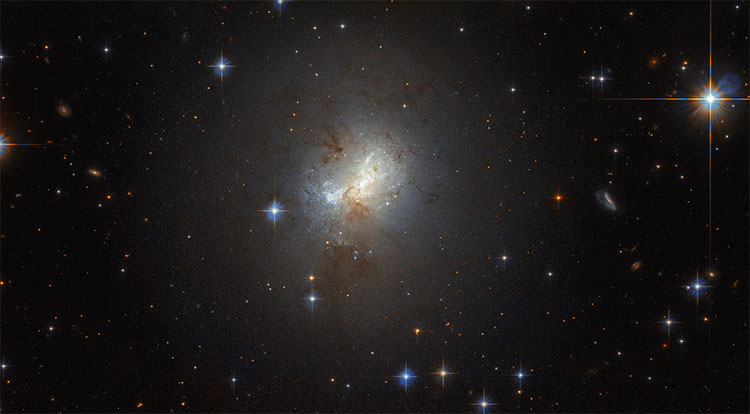The black hole with 1 million sun is the heart of the galaxy 'booming'
Hubble Space Telescope has just captured a strange object near the Roman constellation: a tiny galaxy that is extremely powerful and possesses a monster black hole.
"Star-dwarf dwarf galaxy" is the term scientists use to refer to ESO 495-21, the object that NASA / ESA Space Telescope (US Aeronautics and Space Agency / Space Agency) Europe) just recorded.

The dwarf galaxy carries a "monster" black hole that is too large for Hubble to find - (photo: NASA / ESA).
ESO 495-21 is only 3,000 light-years wide, about 3% of our Milky Way galaxy (most studies estimate that the Milky Way has a diameter of over 100,000 light-years, with research showing that it can be to 180,000 light-years). However, this dwarf galaxy possesses a giant black hole, completely unbalanced with the galaxy's size. It is about 1 million solar masses, about 23.2% of the Milky Way's Sagittarius A * black hole.
Not to mention, this is a young and vibrant world. Like some galaxies of the Starburst group (star boom), inside it is the massive birth of countless newborn stars. ESO 495-21 star-forming speed is 1,000 times faster than the Milky Way.
According to NASA, the object could give clues to the true portrait of galaxies and the first black hole developed in the early universe. This supermassive black hole also brings back the eternal debate about galaxies - black holes: whether the galaxy formed before, then crushed matter at their center and formed a central black hole; Or does a black hole exist first and then gather the material around them into a galaxy?
ESO 495-21 this time has provided strong evidence for the faction to believe that black holes formed before, as well as the heart and seed of the galaxy. The galaxy is found in the area near the constellation of the Compass (Pyxis).
- Detecting black holes 'monsters' 350 million times more massive than the Sun.
- The discovery of the
- Find the missing link on the black hole
- Detecting the supermassive black hole is spraying material
- Super giant black hole discovered
- Black holes are also
- The galaxy's giant black hole
- The first time I took a picture of a black hole three million times bigger than Earth
- Detecting a black hole
- Black holes were stripped when two galaxies collided
- Huge black hole strayed in the galaxy
- Star 'starving' black hole is a billion light years from Earth
 Van Allen's belt and evidence that the Apollo 11 mission to the Moon was myth
Van Allen's belt and evidence that the Apollo 11 mission to the Moon was myth The levels of civilization in the universe (Kardashev scale)
The levels of civilization in the universe (Kardashev scale) Today Mars, the sun and the Earth are aligned
Today Mars, the sun and the Earth are aligned The Amazon owner announced a secret plan to build a space base for thousands of people
The Amazon owner announced a secret plan to build a space base for thousands of people